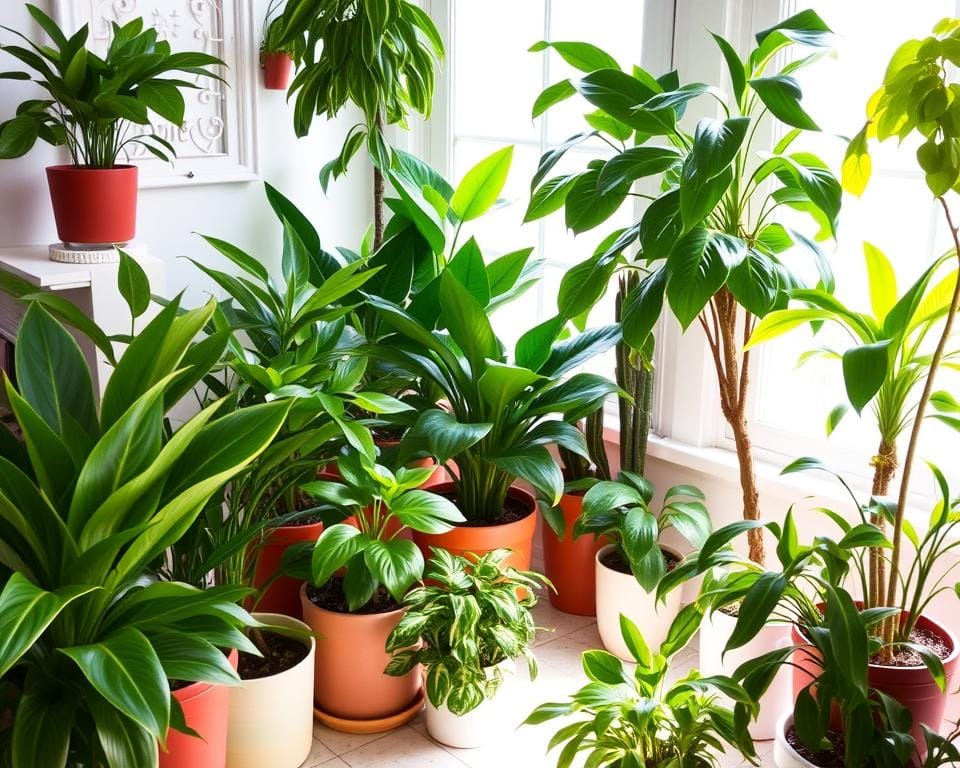Are you new to indoor gardening and unsure which plants are easy to keep alive? Have you had trouble with houseplants before but still want a lush, green space in your home? You’re in the right place! This guide will introduce you to the best indoor plants for beginners that are easy to care for and hard to kill.
Looking after beginner friendly indoor plants is a fun hobby that can make your home look beautiful. They clean the air, lift your mood, and give you a sense of pride as they grow. No matter the size of your home, there are many easy care indoor plants that fit your lifestyle and skill level.
In this article, I’ll share my top picks for the best indoor plants for beginners. You’ll learn how to care for them and help them thrive. From the tough snake plant to the beautiful pothos, you’ll find a variety of low maintenance houseplants that make your home green without taking up too much of your time. Let’s start exploring the easy world of indoor gardening!
Key Takeaways
- Discover the top 10 easy care indoor plants perfect for beginners
- Learn about the benefits of growing houseplants, such as improved air quality and reduced stress
- Understand the key factors to consider when choosing beginner friendly plants
- Get tips on proper watering, fertilizing, and pest control for healthy plants
- Find inspiration to create a thriving indoor garden, even with minimal experience
Introduction to Indoor Plants for Beginners
If you’re new to indoor gardening for beginners, starting with indoor plants can be fun and rewarding. You don’t need a green thumb to care for many beginner houseplants. These plants are easy to look after and can do well indoors.
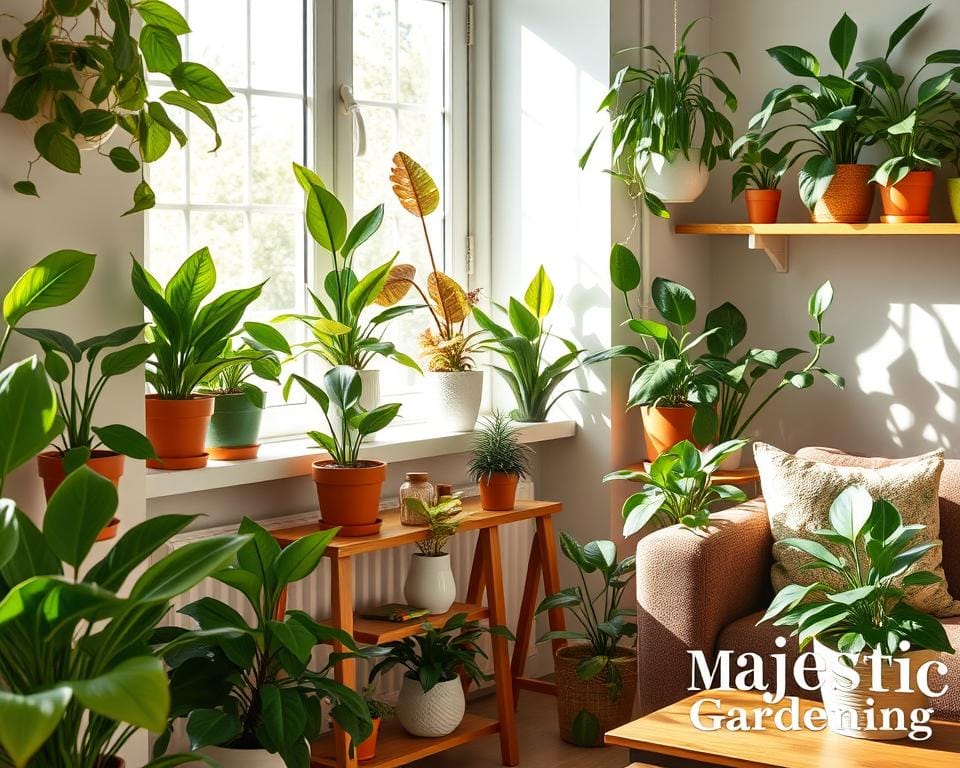
When starting an indoor plant collection, pick plants that fit your home and lifestyle. Think about:
- Light availability
- Watering requirements
- Temperature and humidity levels
- Size and growth habits
The key to successful indoor gardening is to start with plants that are forgiving and adaptable, even if you make a few mistakes along the way.
Choosing the right beginner houseplants lets you enjoy the perks of indoor gardening for beginners. These benefits include:
| Benefit | Description |
|---|---|
| Improved Air Quality | Indoor plants can help filter air pollutants and increase oxygen levels |
| Reduced Stress | Caring for plants can be a relaxing and meditative activity |
| Enhanced Decor | Plants add color, texture, and life to any room |
Next, we’ll look at some top beginner houseplants for your indoor plant collection. These plants will help you start with confidence and success.
Benefits of Growing Indoor Plants
Growing indoor plants does more than make your home look better. They turn your space into a healthier, more lively, and welcoming place. Let’s look at how adding indoor plants to your life can make a big difference.
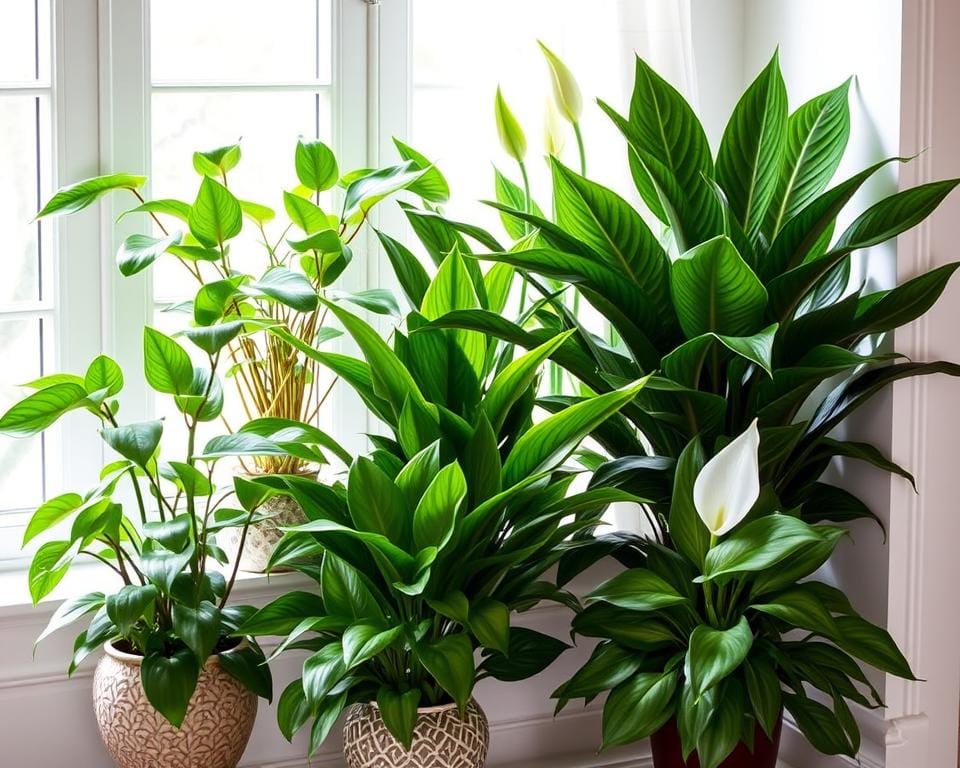
Improving Air Quality
Indoor plants are great at cleaning the air naturally. Plants like snake plants, spider plants, and peace lilies remove toxins and pollutants. They give out clean oxygen instead. Adding these plants at home makes the air healthier for you and your family.
Reducing Stress and Boosting Mood
Studies show that being around indoor plants can really help our mental health. These plants make you feel less anxious and stressed. They bring calmness and peace into your home. Taking care of them can be a calming activity, letting you enjoy nature’s beauty right at home.
Taking care of plants gives us a purpose and is rewarding, especially when you see that first new leaf or flower growing. It’s a great way to relieve stress and spend some time in nature without leaving your home.
Enhancing Home Decor
Indoor plants are not just good for you, they also make your home look better. They come in many shapes, sizes, and colors, fitting any decor style. Whether you like the clean look of succulents or the lush feel of vines, they add beauty and life to your space.
Here are some ways to add plants to your decor:
- Create a living wall with a variety of hanging plants
- Place a large statement plant, such as a fiddle leaf fig, in a corner to add height and visual interest
- Group plants of varying sizes and textures together to create a dynamic display
- Use plants to soften hard edges and bring life to empty spaces
| Plant Type | Air Purifying Properties | Stress Reducing Effects | Decorative Appeal |
|---|---|---|---|
| Snake Plant | High | Moderate | Modern and sleek |
| Spider Plant | High | High | Cascading and whimsical |
| Peace Lily | High | High | Elegant and classy |
Adding air purifying, stress reducing, and decorative plants to your home makes it beautiful and healthy. It also helps you feel connected to nature.
Factors to Consider When Choosing Indoor Plants
Choosing the right indoor plants for your home is key to their health and success. Think about the light they need, how often they need water, and how big they’ll get. This way, you can make a garden that’s both beautiful and easy to care for.
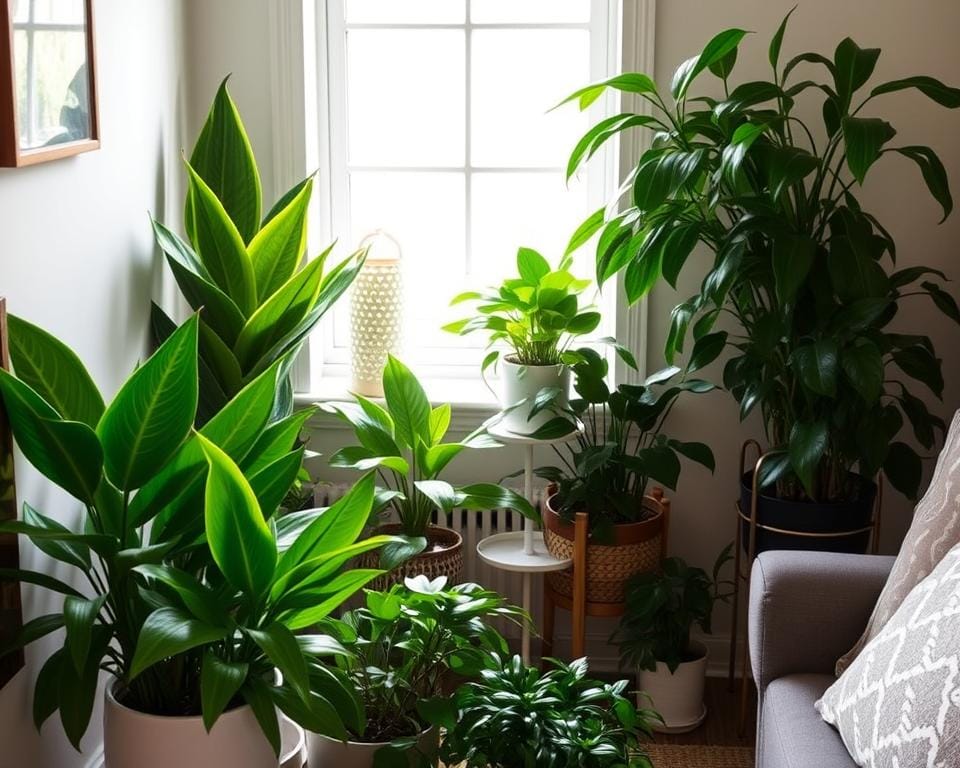
Light Requirements
Light is crucial for indoor plants. Some love bright sunlight, while others do well in low light. Look at your home’s light and pick plants that fit. For low light spots, try ZZ plants, snake plants, and pothos.
Watering Needs
How often you water your plants matters too. Some need a lot of water, while others can go longer between drinks. Pick plants that match your watering routine. Spider plants, aloe vera, and Chinese evergreens are great for busy people or beginners.
Size and Growth Habits
Think about how big your plants will get and how much space you have. Choose plants that won’t take over too fast. Air plants, succulents, and miniature orchids are perfect for small spaces or adding greenery to your desk.
Keep these tips in mind to create a lovely indoor plant collection. It’ll make your home feel alive and full of life.
Best Indoor Plants for Beginners
If you’re new to indoor gardening and want easy-to-care-for houseplants, you’re in the right spot. I’ve listed the best indoor plants for beginners that are easy to look after. They’re great for those starting their indoor gardening journey.
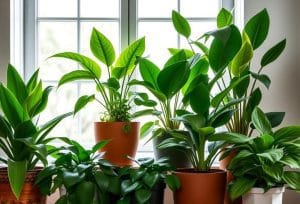
When picking your first indoor plants, think about how much light they need, how often they need water, and if they’re safe for pets or kids. Some plants can be harmful if eaten or if their sap touches skin. So, be careful when choosing.
Here are some top indoor plants for beginners:
| Plant Name | Light Requirements | Watering Needs |
|---|---|---|
| Snake Plant | Low to bright indirect light | Water when soil is dry |
| Spider Plant | Bright indirect light | Water when top inch of soil is dry |
| Pothos | Low to bright indirect light | Water when soil is mostly dry |
| ZZ Plant | Low to bright indirect light | Water when soil is completely dry |
| Chinese Evergreen | Low to medium indirect light | Water when top inch of soil is dry |
These top beginner houseplants are not only easy to care for but also add a touch of greenery and freshness to your living space.
Other easy care indoor plants for beginners include:
- Peace Lily
- Philodendron
- Aloe Vera
- Rubber Plant
- Dracaena
With these beginner-friendly indoor plants, you’ll be on your way to a thriving indoor garden. Make sure to check each plant’s specific care needs. This way, you can give them the right light, water, and care to make them happy in your home.
Snake Plant (Sansevieria trifasciata)
The snake plant, also known as Sansevieria trifasciata, is a great choice for beginners. It’s known for its striking, upright leaves with a unique green and yellow pattern. These plants are not only pretty but also offer many benefits, making them great for indoor spaces.
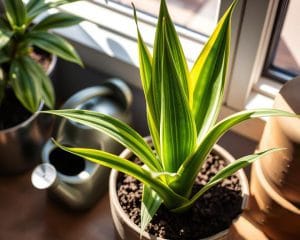
Light and Water Requirements
Snake plants are loved for their ability to grow in low light. They’re perfect for offices or rooms with little natural light. But, they do best in bright, indirect light for growth. They’re also easy to water because they store water in their leaves. Let the soil dry out between waterings to avoid root rot.
Benefits and Uses
Snake plants are more than just pretty; they’re good for you too. They clean the air by removing toxins like formaldehyde and benzene. This makes them great for homes and offices with poor air quality.
They also help reduce stress and improve your mood. Studies show that greenery in a room can make you feel more relaxed and happy. Plus, they’re easy to take care of, so they’re perfect for anyone.
Snake plants can be used in many ways to decorate your home. Their unique leaves add a modern touch to any space. They look great on shelves, desks, or as a floor plant. They also look good with other plants or as a standout piece.
I love my snake plant because it’s so easy to care for and adds a beautiful, modern touch to my home office. It’s the perfect low-maintenance plant for a busy person like me.
| Light | Water | Benefits |
|---|---|---|
| Low to bright indirect light | Allow soil to dry between waterings | Improves air quality |
| Tolerates low light conditions | Drought-tolerant | Reduces stress and boosts mood |
| Avoid direct, harsh sunlight | Well-draining soil and container | Enhances home decor |
In summary, snake plants are a great choice for beginners. They’re easy to care for, clean the air, and look stylish. They offer many benefits that make them valuable in any home or office. Whether you’re busy or forgetful, a low light snake plant will do well under your care.
Spider Plant (Chlorophytum comosum)
The spider plant, known as Chlorophytum comosum, is great for beginners. It’s easy to care for and grows well in many places. This makes it perfect for those new to indoor plants.
This plant looks great in hanging baskets or on columns. Its long, slender leaves can cascade beautifully. The most popular type has green and white stripes.
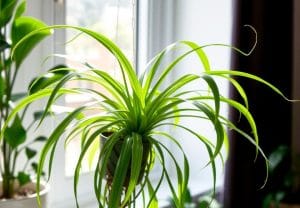
Spider plants are special because they spread by making baby plants. These babies grow on long stems. You can take them off and plant them to make more plants. It’s a fun way for beginners to grow more plants.
I love how my spider plant keeps producing baby plantlets. It’s like having a never-ending supply of new plants to share with friends and family!
This plant is easy to care for. It doesn’t need much water, light, or the right temperature. It can even survive with low light and not much water. This makes it a favorite among new plant owners.
| Care Aspect | Requirements |
|---|---|
| Light | Bright indirect light to low light |
| Water | Allow soil to dry between waterings |
| Temperature | Average room temperature (60-80°F) |
| Humidity | Tolerates low to average humidity |
| Fertilizer | Feed monthly during growing season |
Here are some tips to keep your spider plant happy:
- Put your plant in bright, indirect light. Avoid direct sunlight to prevent leaf burn.
- Water when the top inch of soil feels dry. Make sure the pot drains well.
- Trim off any brown or dead leaves. This keeps your plant looking good and encourages new growth.
The spider plant is perfect for beginners. It’s easy to care for, looks great, and spreads easily. Adding one to your home brings a touch of greenery indoors.
Pothos (Epipremnum aureum)
I’ve discovered that pothos (Epipremnum aureum) is a great plant for beginners. It’s easy to grow and has beautiful, heart-shaped leaves. Pothos can grow well in many conditions, making it perfect for your home or office.
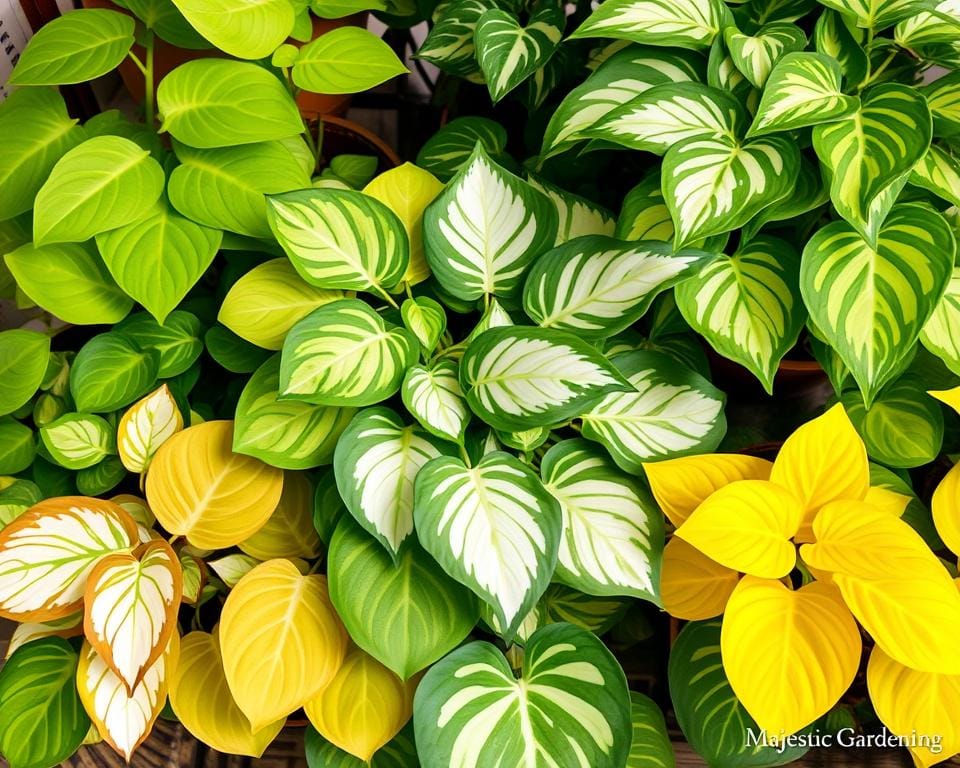
Varieties and Colors
Pothos comes in many varieties and colors, which I find really exciting. You can choose from the classic golden pothos to the bold neon pothos. Some of my top picks are:
- Golden pothos (Epipremnum aureum)
- Marble queen pothos (Epipremnum aureum ‘Marble Queen’)
- Neon pothos (Epipremnum aureum ‘Neon’)
- Jade pothos (Epipremnum aureum ‘Jade’)
- Pearls and jade pothos (Epipremnum aureum ‘Pearls and Jade’)
Each variety has its own unique look, making it easy to mix and match for a beautiful plant collection.
Propagation Methods
Pothos is also easy to spread through propagation. If my plants get too long or I want to share, I just take cuttings. Here’s how to do it:
- Cut a 4-6 inch stem below a leaf node with clean scissors.
- Leave only the top 2-3 leaves after removing the lower ones.
- Put the cutting in water or soil, making sure the nodes are covered.
- Keep the water or soil moist until roots appear, which takes a few weeks.
- Once roots are an inch long, move the cutting to a pot with good drainage.
With the right care, like regular watering and some fertilizing, your new pothos will grow into a beautiful vine.
| Propagation Method | Steps | Time to Root |
|---|---|---|
| Water Propagation | Cut stem, remove lower leaves, place in water | 2-4 weeks |
| Soil Propagation | Cut stem, remove lower leaves, plant in moist soil | 3-5 weeks |
ZZ Plant (Zamioculcas zamiifolia)
The ZZ plant, known as Zamioculcas zamiifolia, is a popular houseplant for both experts and beginners. It thrives in low light and is easy to care for. This makes it a great choice for adding greenery to your home.
Coming from eastern Africa, the ZZ plant grows slowly and can get up to 3 feet tall. Its leaves are oval and grow in pairs, making the plant look full and attractive. The leaves’ waxy coating keeps them moist, making the plant drought-tolerant.

The ZZ plant can live in low light, making it perfect for dark spots in your home or offices. But, it grows slower in low light. So, it’s good to know that.
Watering the ZZ plant is easy. Water it only when the soil is dry, which can be weeks apart. But, don’t overwater to avoid root rot. Make sure the soil drains well.
“I absolutely love my ZZ plant! It’s the perfect easy-care plant for my busy lifestyle. I can forget to water it for weeks, and it still looks amazing.”
The ZZ plant likes soil that drains well. Mixing regular potting soil with perlite or coarse sand helps with drainage. Fertilizing it monthly with a balanced fertilizer during the growing season helps it grow well, but it’s not a must.
ZZ plants are usually pest-free but can get mealybugs or spider mites. Use insecticidal soap or neem oil to treat these pests. Clean the leaves with a damp cloth to remove dust and debris.
The ZZ plant is toxic to humans and pets if eaten. Keep it away from kids and pets. Eating it can cause stomach problems, vomiting, and diarrhea.
In summary, the ZZ plant is great for beginners or anyone wanting a low-light houseplant. Its beauty and easy care make it a favorite worldwide.
Chinese Evergreen (Aglaonema)
The Chinese evergreen, also known as Aglaonema, is a favorite among beginners. It’s easy to care for and has beautiful leaves. These plants do well in low light, perfect for places with little sunlight. With the right care, they can make any space look better and improve the air quality.

Popular Varieties
There are many Aglaonema varieties to pick from, each with unique leaves and colors. Some top choices include:
- Silver Queen: Known for its stunning silver and green variegated leaves
- Red Siam: Boasts striking red and pink hues on its foliage
- Maria: Features dark green leaves with beautiful white and pink highlights
- Emerald Bay: Displays lush, deep green leaves with subtle silver markings
I absolutely adore my Silver Queen Aglaonema! Its beautiful variegated leaves add a touch of elegance to my living room, and it’s so easy to care for.
Ideal Growing Conditions
To keep your Chinese evergreen happy, make sure it has the right conditions. These plants like:
| Condition | Requirement |
|---|---|
| Light | Low to moderate indirect light; avoid direct sunlight |
| Water | Water when top inch of soil feels dry; avoid overwatering |
| Humidity | Moderate humidity; mist leaves occasionally or use a pebble tray |
| Temperature | 60-85°F (15-29°C); protect from cold drafts and extreme temperature fluctuations |
| Soil | Well-draining potting mix; add perlite or coarse sand for better drainage |
| Fertilizer | Feed monthly during growing season with a balanced, water-soluble fertilizer |
Give your Chinese evergreen the best conditions and care, and you’ll have a beautiful plant for years. It will brighten up your home.
Peace Lily (Spathiphyllum)
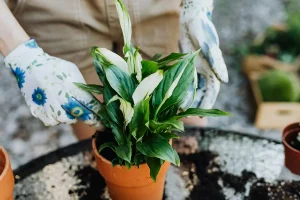
The peace lily, or Spathiphyllum, is a stunning indoor plant that adds elegance to any room. It has glossy, dark green leaves and beautiful white spathes. This makes it a favorite among both beginners and experienced plant lovers. It looks great and offers many benefits, making it a top choice for your home.
Peace lilies are great because they can grow in low light. They prefer bright, indirect light but can do well in less light, like offices or bedrooms with few windows. This is perfect for those who can’t have the best lighting for other plants.
Peace lilies like soil that’s always a bit moist but can handle short dry spells. I water them when the top inch of soil feels dry. Don’t overwater, as this can cause root rot. They will droop a bit when they need water but bounce back quickly after.
Peace lilies are not only beautiful but also excellent at purifying the air, making them a healthy addition to any home or office space.
Peace lilies can produce stunning white spathes that look like flowers. These can show up any time of the year if the conditions are right. They add a lovely contrast to the dark green leaves. To get them to bloom, make sure they get enough bright, indirect light and get regular fertilizer during the growing season.
Here are some tips for taking care of your peace lily:
- Provide bright, indirect light for the best growth and blooms
- Water when the top inch of soil feels dry, and avoid overwatering
- Fertilize monthly during the growing season for best results
- Keep away from pets and children, as peace lilies are toxic if ingested
| Light | Water | Humidity | Temperature |
|---|---|---|---|
| Bright, indirect light | Water when top inch of soil is dry | Moderate to high humidity | 60-85°F (15-29°C) |
In conclusion, the peace lily is a great addition to any indoor plant collection. It’s adaptable to low light, purifies the air, and has beautiful spathes. With these simple care tips, you’ll enjoy the beauty and benefits of this amazing plant for years.
Philodendron
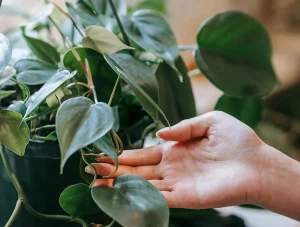
Philodendrons are a diverse and popular group of tropical plants. They are loved by both beginners and experienced plant lovers. These plants are easy to grow and come in many shapes, sizes, and colors. They make a great addition to any indoor space.
Philodendrons come from the tropical parts of the Americas. They love warm, humid places with some sunlight. In the wild, they can grow big, climbing trees or spreading out on the forest floor. As houseplants, they stay smaller but still look lush and tropical.
Types of Philodendrons
There are many philodendron types to pick from, each with its own look. Some popular ones include:
- Heartleaf Philodendron (Philodendron hederaceum): This vine has heart-shaped leaves and is great for hanging baskets or draping over shelves.
- Split-leaf Philodendron (Monstera deliciosa): Often thought to be a true philodendron, this plant has big, holey leaves and stands out as a beautiful piece.
- Tree Philodendron (Philodendron bipinnatifidum): This type grows tall and has big, deeply cut leaves, looking like a small tree.
- Lacy Tree Philodendron (Philodendron selloum): Like the tree philodendron, but with more delicate, lacy leaves and a more compact size.
Care and Maintenance
Philodendrons are popular among beginners because they are easy to care for. They can handle a lot of different growing conditions. This makes them perfect for those new to indoor plants.
For heartleaf philodendron care, focus on light, water, and humidity. They like bright, indirect light but can do well in less light. Water them when the top inch of soil feels dry, and don’t let them sit in water. These plants like more humidity, so misting the leaves or using a humidity tray can help.
Feeding your philodendron with fertilizer during the growing season is also good. Use a balanced, water-soluble fertilizer once a month for healthy growth and lots of leaves. Pruning your philodendron now and then keeps it looking good and encourages fuller growth.
Philodendrons are a top choice for beginners because they are easy to care for and come in many types. With the right care and a little love, you can enjoy these beautiful plants in your home for many years.
Aloe Vera
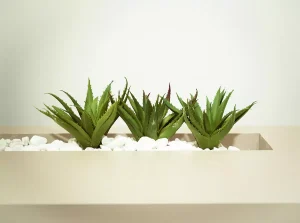
Aloe vera is a popular succulent that’s easy to grow and packed with health benefits. It’s perfect for beginners who want to bring some greenery into their homes. Plus, it offers a natural remedy right at your fingertips.
One great thing about aloe vera is how easy it is to care for. It loves well-draining soil and can survive with little water, making it great for forgetful plant owners. Just give it a sunny spot, like a windowsill, and water it every 2-3 weeks, depending on your home’s humidity and temperature.
“Aloe vera has been used for centuries to treat various skin conditions, including burns, cuts, and irritations. Its gel contains compounds that have anti-inflammatory and soothing properties, making it a go-to remedy for many households.”
The gel inside aloe vera leaves is its most valuable part. It’s full of vitamins, minerals, and amino acids that help with skin health and healing. To get the gel, cut off a mature leaf near the base, then slice it open to reveal the gel inside.
Aloe vera is not just useful; it’s also a beautiful plant for your indoor garden. Its long, green leaves grow in a rosette shape and have spiny edges. This makes it a standout piece that fits many decor styles.
When starting your indoor gardening, think about adding an aloe vera plant. You’ll be proud of your easy-care succulent and have a natural remedy ready when you need it.
Rubber Plant (Ficus elastica)
The rubber plant, known as Ficus elastica, is a favorite among indoor gardeners. Its shiny, thick leaves and simple care make it a top choice for homes and offices. These plants can grow tall but can be pruned to fit indoor spaces.
To care for a rubber plant, focus on the right environment. They love bright, indirect light and soil that drains well. Water when the top inch of soil is dry, and drain the saucer to prevent root rot. With the right care, your plant will flourish and add beauty to your space.
Pruning and Shaping
Pruning is a big plus for rubber plants. It helps control size, encourages bushy growth, and makes the plant look fuller. Use sharp tools for pruning to avoid harm. Cut just above a node to encourage new leaves.
I find that pruning my rubber plant in the spring or early summer, just before its active growing season, yields the best results. It’s amazing how quickly new leaves emerge after a good trim!
Common Issues and Solutions
Sometimes, even with good care, rubber plants face problems. Here are some common ones:
- Yellowing leaves: Often caused by overwatering. Let the soil dry out more between waterings.
- Leaf drop: Usually from drafts, temperature changes, or low humidity. Keep your plant in a stable spot and use a humidifier if needed.
- Brown leaf tips: May mean underwatering or low humidity. Water more often and mist the leaves.
Watch for these issues and fix them quickly to keep your rubber plant healthy. A little care ensures your Ficus elastica stays beautiful for years.
Dracaena
Dracaena plants are great for indoor gardening beginners. They are easy to care for and can grow well in different light conditions. The dracaena marginata, or dragon tree, is a popular type with red-edged leaves.
To care for dracaena plants, use well-draining soil and water them just right. Don’t overwater, as this can cause root rot. These plants can live in low to bright indirect light, fitting many indoor spaces.
I love how dracaenas can instantly add a tropical vibe to any room. Their lush foliage and easy care requirements make them a perfect choice for beginner plant parents.
Dracaenas are not just pretty; they also clean the air. They remove harmful toxins like formaldehyde and benzene from the air. This makes them a great choice for homes and offices.
Some popular dracaena species include:
- Dracaena fragrans (corn plant)
- Dracaena sanderiana (lucky bamboo)
- Dracaena reflexa (song of India)
- Dracaena draco (dragon tree)
Keep your dracaena’s leaves clean to help them photosynthesize well. If leaves turn yellow or brown, it might mean you’re watering too much or the soil lacks good drainage. Adjust your watering based on this.
Dracaenas are perfect for indoor plants because they’re easy to care for and look great. Whether you pick a dracaena marginata or another type, these plants will add tropical beauty to your space. They also clean the air and enhance your decor with greenery.
Tips for Maintaining Healthy Indoor Plants
Proper care is key for your indoor plants to thrive. Follow these indoor plant care tips to keep your houseplants looking great. This way, you can enjoy their beauty and benefits for many years.
Proper Watering Techniques
Watering houseplants right is crucial. Here are some tips:
- Water your plants well, letting the water drain from the pot’s bottom holes.
- Don’t let your plants sit in water, as it can cause root rot.
- Most plants like to dry out a bit before you water them again.
- Change your watering schedule based on the plant type, pot size, and your environment.
Fertilizing and Repotting
Fertilizing indoor plants gives them the nutrients they need. Here are tips for fertilizing and repotting:
- Fertilize your plants in the growing season, usually spring through fall.
- Use a balanced, water-soluble fertilizer made for indoor plants.
- Follow the fertilizer package for how to mix and apply it.
- Repot your plants when they’re too big for their pot or the soil is worn out.
- Choose a pot one size bigger and use fresh, well-draining potting mix.
Pest Control and Disease Prevention
Preventing pests and diseases is key for your indoor plants. Here are some strategies:
- Check your plants often for pests or diseases, like yellow leaves or sticky spots.
- Keep sick plants away from others to stop pests or diseases from spreading.
- Use insecticidal soap, neem oil, or fungicide to treat infested plants.
- Keep your plants happy with enough light, humidity, and airflow.
- Clean your plants’ leaves often to remove dust and pests.
“Proper care is the key to success with indoor plants. By following these essential tips for watering, fertilizing, repotting, and preventing pests and diseases, you can enjoy a thriving indoor garden that enhances your home’s beauty and your well-being.”
By using these indoor plant care tips, you’ll be on your way to a lush indoor plant collection. This will bring you joy and improve your living space.
Conclusion
Starting an indoor plant collection is rewarding for beginners. Choose plants like snake plants, spider plants, and pothos for easy care. These plants are perfect for those new to indoor gardening.
When picking easy houseplants, think about their light, water, and growth needs. This ensures they do well in your home. Proper care, including watering, fertilizing, and controlling pests, keeps your plants healthy and bright.
Patience is crucial with indoor plants. As you get more experience, you can add more types to your collection. With the right plants and care, anyone can succeed in indoor gardening and enjoy its many benefits.
FAQ
What are the best low light indoor plants for beginners?
Great low light indoor plants for beginners include snake plants, ZZ plants, Chinese evergreens, and peace lilies. These plants thrive in low light and need little care. They’re perfect for those new to indoor gardening.
How often should I water my indoor plants?
How often you water depends on the plant type. Most prefer to dry out a bit between waterings. Water them when the top inch of soil feels dry. Don’t overwater, as it can cause root rot.
What are some easy care hanging plants for beginners?
Spider plants and pothos are great for beginners. They adapt to different lights and are easy to care for. They also look beautiful in hanging baskets or on shelves.
How can I tell if my indoor plant needs to be repotted?
Look for signs like roots coming out of the drainage holes, soil drying out fast, or slow growth. Most plants need a new pot every 1-2 years, based on their growth and pot size.
What are some easy to grow flowering indoor plants for beginners?
Peace lilies and African violets are easy for beginners. Peace lilies bloom often with the right care. African violets have many colors and fit well in small spaces.
How can I prevent pests and diseases on my indoor plants?
Check your plants often for pests or diseases, like yellow leaves or sticky spots. Keep them healthy with the right light, water, and food. If you find problems, isolate the plant and use insecticidal soap or neem oil to treat it.
Source Links
- Houseplants for Beginners: How to Keep House Plants Alive
- 30 Best Houseplants for Beginners
- Easy Houseplants Even Beginners Can’t Kill

